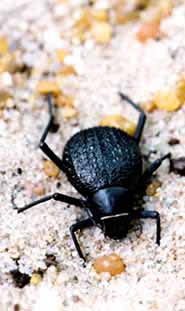Water wings aid desert survival

Back draught: this beetle drinks the water its bumps collect. <br>© Parker/Lawrence
Humans learn water-gathering trick from bumpy beetle.
A desert beetle turns fog into drinking water with its wings, new research reveals. Materials mimicking the insect could help humans survive harsh environments.
Southwest Africa’s Namib Desert is one of the hottest and driest places on Earth. There is no rain, but on about six mornings a month a fog blows in off the Atlantic and across the land at gale force.
The beetle Stenocara traps this fleeting resource, zoologist Andrew Parker, of the University of Oxford, and Chris Lawrence, of QinetiQ, the commercial arm of the UK defence ministry, have discovered. The insect’s hard front wings are covered in bumps. The peaks attract water and the valleys repel it1.
The beetle faces into the wind with its wings aloft. Fog droplets stick to the water-attracting bumps and coalesce. When they are big enough to touch a water-repelling valley, they roll down into the beetle’s mouth.
It’s an easy trick, and cheap to reproduce. Similar materials can be made using screen printing and injection moulding, or even with a computer printer that sprays water-attracting ink onto an acetate sheet.
Parker and QinetiQ are now optimizing the design and production of fog-collecting materials. Their current efforts are already “several times more efficient” than other fog collectors, says Parker. A product – probably a tent that can gather drinking water for its occupants – should be on the market within a year, he says.
The mists of time
People have collected fog to drink for centuries. Two thousand years ago, the Roman writer Pliny the Elder described how inhabitants of the Canary Islands gathered fog droplets trapped by trees. Stones placed around the trees to collect the drips are still there today.
Robert Schemenauer, of Environment Canada in Toronto, advises an ever-growing number of fog-collecting projects across the world. One of the first, set up in the Chilean village of Chungungo in 1987, now supplies 700 people with 15,000 litres of water each day.
Plastic mesh is Schemenauer’s fog-collecting material of choice. It is cheap, efficient and robust, he says. But improvements are always welcome: “If something can be transferred from a beetle to a building material it could help a lot,” he says.
Beetle-inspired material might be particularly suited to gathering dew, says Schemenauer, where there is a problem of making the water droplets run off the collecting surface.
References
- Parker, A. R. & Lawrence, C. R Water capture by a desert beetle. Nature, 414, 33 – 34, (2001).
Media Contact
All latest news from the category: Life Sciences and Chemistry
Articles and reports from the Life Sciences and chemistry area deal with applied and basic research into modern biology, chemistry and human medicine.
Valuable information can be found on a range of life sciences fields including bacteriology, biochemistry, bionics, bioinformatics, biophysics, biotechnology, genetics, geobotany, human biology, marine biology, microbiology, molecular biology, cellular biology, zoology, bioinorganic chemistry, microchemistry and environmental chemistry.
Newest articles

Machine learning algorithm reveals long-theorized glass phase in crystal
Scientists have found evidence of an elusive, glassy phase of matter that emerges when a crystal’s perfect internal pattern is disrupted. X-ray technology and machine learning converge to shed light…

Mapping plant functional diversity from space
HKU ecologists revolutionize ecosystem monitoring with novel field-satellite integration. An international team of researchers, led by Professor Jin WU from the School of Biological Sciences at The University of Hong…

Inverters with constant full load capability
…enable an increase in the performance of electric drives. Overheating components significantly limit the performance of drivetrains in electric vehicles. Inverters in particular are subject to a high thermal load,…





















